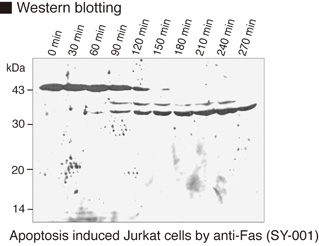Anti-Caspase-9 (Human) mAb
| Code | Size | Price |
|---|
| MBL-M054-3 | 100 ug | £296.00 |
Quantity:
Prices exclude any Taxes / VAT
Overview
Host Type: Mouse
Antibody Isotype: IgG1
Antibody Clonality: Monoclonal
Antibody Clone: 5B4
Regulatory Status: RUO
Target Species:
- Human
- Mouse
- Rat
Application: Western Blot (WB)
Shipping:
4°C
Storage:
-20°C
Images
Documents
Further Information
Applications:
WB - 1 ug/mL (chemiluminescence detection system)
Background:
Apoptosis is a major form of cell death characterized by morphological features including chromatin condensation and fragmentation, cell membrane blebbing, and formation of apoptotic bodies. These morphological changes occur via signaling pathways that lead to the recruitment and activation of caspases, a family of cysteine-containing, aspartate-specific proteases. Caspases exist as inactive proenzymes in cells and are activated through their processing into two subunits in response to apoptotic stimulation. Activated caspases cleave a variety of important cellular proteins, other caspases, and Bcl-2 family members, leading to a commitment to cell death. Caspase-7 (also known as Mch-3/ ICE-LAP3 / CMH-1) is a 35 kDa protein that has the highest similarity to caspase-3 (52% amino acid identity) among all caspase members. It has been identified as one of the ''effector'' caspases (which include caspase 3, 6, 7) that are cleaved by ''initiator'' caspases (which include caspase 8, 9) into active form, and then, in turn, cleave various cellular proteins for apoptosis. Recent study says that in Fas-mediated hepatocyte apoptosis, active caspase-7 is associated almost exclusively with the mitochondrial and microsomal fractions, whereas active caspase-3 is confined primarily to the cytosol. It implies a different role of caspase-3 and -7 in the execution of apoptosis.
Concentration:
1 mg/mL
Formulation:
100 ug IgG in 100 ul volume of PBS containing 50% glycerol, pH 7.2. No preservative iscontained.
Gene IDs:
Human: 842 Mouse: 12371 Rat: 58918
Immunogen Translated:
Recombinant Caspase-9 (:1-250 aa terminal N)
Reactivity:
This antibody reacts with human, mouse
and rat 45 kDa of pro-caspase-9 and cleaved 35 or 37 kDa
products.
Shelf Life:
1 year
Source:
This antibody was purified from mouse ascites
fluid using protein A agarose. This hybridoma (clone 5B4)
was established by fusion of mouse myeloma cell P3U1
with Balb/c mouse splenocyte immunized with the
recombinant protein corresponding to N-terminal amino
acids (1-250 aa) of human caspase-9.
Target:
Caspase-9
References
1) Phillips, D. C., et al., Cancer Res. 67, 756-764 (2007)
2) Yamamoto, M., et al., Cancer Res. 65, 8706-8714 (2005)
3) Park, W. R., and Nakamura, Y., Cancer Res. 65, 1197-1206 (2005)
4) Martin, S., et al., Cancer Res., 65, 11447-11458 (2005)
5) Twiddy, D., et al., J. Biol. Chem. 279, 19665-19682 (2004)
6) Sato, T., et al., J. Immunol. 173, 285-296 (2004)
7) Wagner, K. W., et al., J. Biol. Chem. 279, 35047-35052 (2004)
8) Yakovlev, A. G., et al., J. Biol. Chem. 279, 28367-28374 (2004)
9) Tosa, N., et al., Int. Immunol. 15, 741-749 (2003)
10) Nakazawa, Y., et al., J. Biol. Chem. 278, 27888-27895 (2003)
11) Muthumani, K., et al., J. Biol. Chem. 277, 37820-37831 (2002)
12) Yakovlev, A. G., et al., J. Neurosci. 21, 7439-7446 (2001)
Clone 5B4 is used in these references.
As clone 5B4 is really famous all over the world, a lot of
researches have been reported. These references are a
part of such reports.




